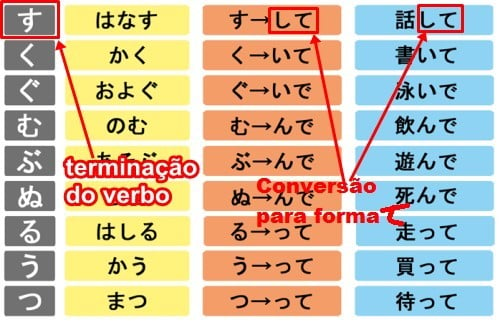Te is one of the most fundamental forms in Japanese. Anyone who is starting to learn Japanese must have already come across the way て (te). for those who haven't gotten there yet, form て (te) serves to conjugate verbs, make requests and list actions done in the same sentence.
Therefore, I will explain from now on how this form works in the Japanese language. Check out:
1. "te" (て) form - To make a wish
First, this form is used to ask someone something informally. To use this form, what you have to do is change the ending of the verb by converting it to the form て. A basic example: Let's use the verb 食べる (taveru) which means "to eat". The verb ending is る. Therefore, in shape て, would be 食べて (tablet) which means "eat".
However, depending on the ending of the verb, you will not put exactly て at the place. Below is a list of how to use this form:
you can click in that article from the website Japanese classes for more details on how to use this form to place an order.
2. "te" (て) form - For verb conjugation
This form also serves to conjugate verbs in the present continuous tense. Indicates that the person is currently taking some action. In this sense, it is comparable to the form "ndo" of Portuguese when we want to say that we are doing something. To conjugate, add the て + いる form.
Examples:
- する (do) - Verb to do/ て + いる shape - している (shiteiru) - Doing
- くる(kuru) - Verb to come/ て + いる shape - きている (kiteiru) - Coming
- 飲む (name) - Verb to drink/ て + いる shape - 飲んでいる (nondeiru) - Drinking
- 遊ぶ (asobu) - verb play/ て + いる shape - 遊んでいる (asondeiru) - Joking
- 殺す (kill) - Verb to kill/ て + いる shape - 殺している (koroshiteiru) - Killing
- 聞く (kiku) - Verb listen/ て + いる shape - 聞いている (kiteiru) - listening
- In short, you will use the shape て and add いる to the verb you are conjugating;
3. "te" (て) form - To connect words
Likewise, this form can also be used to connect words. However, if you use て to connect only verbs. For example, let's use the following sentences:
- 今日は起きてました (kyou wa okitemashita/Today, I got up)
- 朝ご飯を食べました (asagohan wo tabemashita/I had breakfast)
- 学校に行きました (I went to school/I went to school)
How are we going to connect these sentences? It's simple. using the shape shape て, three sentences look like this:
今日は起きて、朝ご飯を食べて、学校に行きました。
(Today wa okite, asagohan wo tabete, gakkou ni ikimashita/Today I got up, had breakfast and went to school)
Thus, the three sentences are connected with each other to establish a chronological order of events. However, only the last verb is in the polite form (ます form). If you are going to write a sentence in the polite form, always leave the last verb in the ます form.
That's all, folks. I hope you enjoyed the article and don't forget to share it with your friends.






